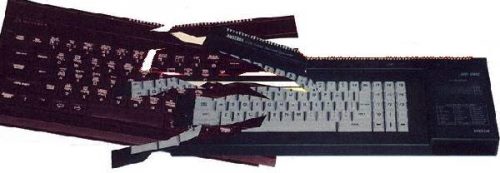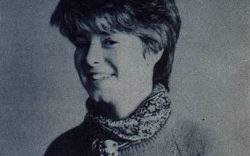

It was a supremely logical move, really, the liaison between the boffin and the barrow boy.
Sir Clive Sinclair’s commercial past, not without its successes, has followed an erratic and at times traumatic course. His talent for innovation has never been in dispute — his technological advances have contributed a great deal to the quality of life, if not exactly to the fabric of society, and his inventing career began while he was still in his teens.
Alan Sugar was another teenager who showed promise — starting out as a street trader selling car aerials he has applied his marketing expertise consistently well, arranging for products that people want, to be manufactured at a price they trip over themselves to pay. Now Alan Sugar is personally worth over two hundred million pounds, and heads up a remarkably successful company.
Clive Sinclair’s computer products are now owned and will soon be sold by Amstrad, who can apply their marketing genius to the fruits of Sinclair’s hardware genius. The £5 million cash Amstrad stumped up for the intellectual and marketing rights for Sinclair’s computers represents a bargain — there’s little doubt that Amstrad should be able to recoup their investment within twelve months. Even if Amstrad have to spend a further ten or eleven million pounds for the stocks, work in progress and committed orders under the terms of the agreement announced on 7th April, they have still got a remarkably good deal. A total investment of some £15 million for the Sinclair name, the existing range of Sinclair computers and the first option on any new computer related products from the Sinclair stable wasn’t too painful a commitment for Amstrad to make, considering their profits for the last six months of 1985 weighed in over the £27 million mark.
Not so long ago Clive Sinclair was firmly in the limelight, knighted, invited to Downing Street to give his opinions on technology, head of a roaringly successful computer company and personally worth so many millions they were hardly worth counting. Clive Sinclair was firmly in the public eye. Most people had heard of Amstrad, but Alan Sugar was hardly a household name.
Now the tables have turned. Alan Sugar is personally worth more than twice as much as Sir Clive ever was, heads a company which dominates the UK home computer market (amongst other things) and is the Golden Boy of City Institutions who are knocked out by Amstrad’s escalating profit figures. Sir Clive Sinclair is returning to the research that is included in the title of his company. Sinclair Research has done the honourable thing, arranged to pay off all its debts and left the home computer market. Sir Clive retains rights to the pocket television and has set up two companies under the wing of Sinclair Research to develop wafer scale integrated circuits and telecommunications products.
Apart from the commercial sense involved in buying up a competitor whose share of the market — entertainment computers — your company covets, Amstrad may have had another reason for acquiring a ready-made product range. The QL is likely to be scrapped or sold off. Amstrad has control over the Spectrum 48, PLUS and 128 and has first option on the Pandora. Maybe Amstrad’s involvement with the Spectrum will provide the answer to many a Spectrum owner’s dream — disc drives at a reasonable price.
Admittedly three and half inch drives for the Spectrum were announced a few weeks before the Amstrad takeover. But it just might fit in with Amstrad’s plans to add three inch drives, as used in their existing range of computers, to the Spectrum. They have the purchasing power to market the appropriate drive and interface for a price that competes favourably with the Interface 1 and Microdrive set-up. Amstrad’s new machine, compatible with the IBM PC has to use five and a quarter inch drives. The fact that Amstrad’s next machine will not be incorporating three inch drives could possibly have contributed to the continuing reluctance of disc manufacturers to increase production of the three inch medium. Perhaps the Sinclair tie-in will be used by Amstrad as a carrot to nudge disc manufacturers into ending the current, painful shortage of three inch discs. An end to the shortage of three inch discs would have immense benefits for Amstrad themselves, software houses and users of Amstrad machines.
And with Amstrad’s new found commitment to entertainment computing centred on their new acquisition, the Spectrum, the games playing world could be in for a boost. There’s no reason why the board in the basic 48K machine couldn’t be dropped into a case which included a joystick interface, cassette deck or disc drive and didn’t have a keyboard. A games console, no more and no less. The same board could be an add-on for Amstrad’s IBM lookalike and other machines in its range, sold as a peripheral which gave the serious users Amstrad likes to feel it has snapped up fancy a bit of light entertainment.
“Nothing ever goes the way I plan it”, Sir Clive said at the press conference called to announce the sale of Sinclair’s computer rights to Amstrad. In the long run, for Spectrum games players and everyone else involved in the market, it’s unlikely he could have planned it better.

Gorgeous pouting monthly CRASH... No Stoppit now. Right this instant. We’ll have none of that sort of thing in THIS magazine, thankyouverymuch.
Hannah Smith has travelled all the way from sunny Weston super Mare (gateway to somewhere or other down south) to sunny Ludlow (gateway to the Welsh Marches, whatever they might be). She’s joined the CRASH team as a Staff Writer with special responsibilities for organising the software reviews. No doubt you’ll be reading a lot more of her over the coming months. Welcome to CRASH, Hannah, and it’s your turn to chip in for the Tea Kitty...